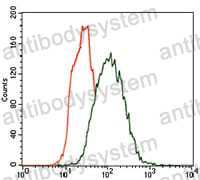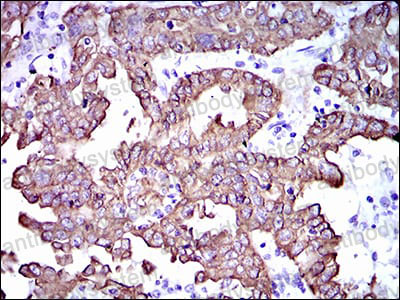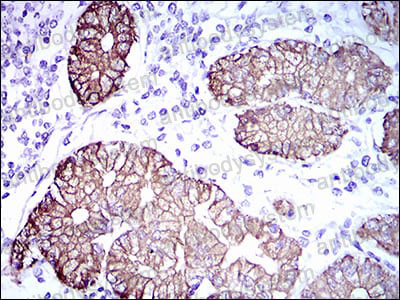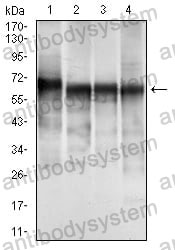Catalog No.
RHC99507
Species reactivity
Human
Host species
Mouse
Isotype
IgG1
Clonality
Monoclonal
Tested applications
ELISA: 1:10000, FCM: 1:200-1:400, IHC: 1:200-1:1000, WB: 1:500-1:2000
Target
Type-II keratin Kb5, Keratin, type II cytoskeletal 5, K5, 58 kDa cytokeratin, Cytokeratin-5, CK-5, KRT5, Keratin-5
Concentration
1 mg/ml
Endotoxin level
Please contact with the lab for this information.
Purity
>95% as determined by SDS-PAGE.
Purification
Protein A/G purified from cell culture supernatant.
Accession
P13647
Applications
ELISA, FCM, IHC, WB
Form
Liquid
Storage buffer
0.01M PBS, pH 7.4, 0.05% Sodium Azide.
Stability and Storage
Use a manual defrost freezer and avoid repeated freeze-thaw cycles. Store at 4°C short term (1-2 weeks). Store at -20°C 12 months. Store at -80°C long term.
Clone ID
R3D37
Deciphering the Molecular Landscape of Urothelial Carcinoma: Immunohistochemistry-based Subtyping Using 4 Easily Available Antibodies for Cost-effective Stratification., PMID:40497570
Tear duct M cells exacerbate allergic conjunctivitis by facilitating germinal-center reactions., PMID:39900200
Identification of a Novel Subset of Human Airway Epithelial Basal Stem Cells., PMID:39337350
Candidate proteins interacting with cytoskeleton in cells from the basal airway epithelium in vitro., PMID:39139811
Feasibility and Impact of Immunohistochemistry-based Molecular Subtyping for Muscle-invasive Bladder Cancer in Patients Treated with Radiation-based Therapy., PMID:38020525
Keratin 5 in Lung Cancer Specimens: Comparison of Four Antibody Clones and KRT5 mRNA-ISH., PMID:37212698
Immunohistochemical Assays for Bladder Cancer Molecular Subtyping: Optimizing Parsimony and Performance of Lund Taxonomy Classifiers., PMID:35437049
Bimodal fibrosis in a novel mouse model of bleomycin-induced usual interstitial pneumonia., PMID:34728556
Diagnostic and prognostic implications of a three-antibody molecular subtyping algorithm for non-muscle invasive bladder cancer., PMID:34697907
Molecular and immunohistochemical evaluation of BAP-1 antibody in bladder cancer and comparison with luminal-basal subtyping., PMID:33341088
CD44v3-Positive Intermediate Progenitor Cells Contribute to Airway Goblet Cell Hyperplasia., PMID:33264080
Efficacy of neoadjuvant atezolizumab treatment in patients with advanced urothelial bladder cancer according to the BASQ classification: a study protocol for an open-label, two-cohort, phase II trial., PMID:33060077
A direct immunohistochemistry (IHC) method improves the intraoperative diagnosis of breast papillary lesions including breast cancer., PMID:31926580
A direct immunohistochemistry (IHC) method improves the intraoperative diagnosis of breast papillary lesions including breast cancer., PMID:31465723
Molecular pathology of the luminal class of urothelial tumors., PMID:31232464
Mesenchymal stem cells differentiate into keratinocytes and express epidermal kallikreins: Towards an in vitro model of human epidermis., PMID:30891818
Searching for serum protein markers of equine squamous gastric disease using gel electrophoresis and mass spectrometry., PMID:30636330
Burnlike scars: A sign suggestive of KLHL24-related epidermolysis bullosa simplex., PMID:29574966
What we have lost: Mastitis resistance in Holstein Friesians and in a local cattle breed., PMID:29223308
Pathological expression of tissue factor confers promising antitumor response to a novel therapeutic antibody SC1 in triple negative breast cancer and pancreatic adenocarcinoma., PMID:28938620
Anthralin modulates the expression pattern of cytokeratins and antimicrobial peptides by psoriatic keratinocytes., PMID:28673488
Keratin 5 overexpression is associated with serous ovarian cancer recurrence and chemotherapy resistance., PMID:28147318
The expression patterns of aquaporin 9, vacuolar H+-ATPase, and cytokeratin 5 in the epididymis of the common vampire bat., PMID:27549752
Detection and quantification of epithelial progenitor cell populations in human healthy and IPF lungs., PMID:27423691
Influenza Virus Infects Epithelial Stem/Progenitor Cells of the Distal Lung: Impact on Fgfr2b-Driven Epithelial Repair., PMID:27322618
Isolating RNA from precursor and mature melanocytes from human vitiligo and normal skin using laser capture microdissection., PMID:27193292
Expressions of Thyroid Transcription Factor-1, Napsin A, p40, p63, CK5/6 and Desmocollin-3 in Non-Small Cell Lung Cancer, as Revealed by Imprint Cytology Using a Malinol-Based Cell-Transfer Technique., PMID:26696549
Changes in the Submandibular Salivary Gland Epithelial Cell Subpopulations During Progression of Sjögren's Syndrome-Like Disease in the NOD/ShiLtJ Mouse Model., PMID:26179322
Cytokeratin 5/6 fingerprinting in HER2-positive tumors identifies a poor prognosis and trastuzumab-resistant basal-HER2 subtype of breast cancer., PMID:25742793
Aberrant differentiation of urothelial cells in patients with ureteropelvic junction obstruction., PMID:25337225
Epithelial basal cells are distinct from dendritic cells and macrophages in the mouse epididymis., PMID:24648397
T-lymphocytes are directly involved in the clinical expression of migratory circinate erythema in epidermolysis bullosa simplex patients., PMID:24104543
Constitutive β-catenin activation induces male-specific tumorigenesis in the bladder urothelium., PMID:23928991
Keratolysis exfoliativa (dyshidrosis lamellosa sicca): a distinct peeling entity., PMID:23039091
Verrucous carcinoma in epidermolysis bullosa simplex is possibly associated with a novel mutation in the keratin 5 gene., PMID:22639907
Tissue-sparing application of the newly proposed IASLC/ATS/ERS classification of adenocarcinoma of the lung shows practical diagnostic and prognostic impact., PMID:22586054
Mutations in KRT5 and KRT14 cause epidermolysis bullosa simplex in 75% of the patients., PMID:21375516
Caged fluorescent haptens reveal the generation of cryptic epitopes in allergic contact dermatitis., PMID:21228815
Clinical heterogeneity in recessive epidermolysis bullosa due to mutations in the keratin 14 gene, KRT14., PMID:18713255
Role of integrins, tetraspanins, and ADAM proteins during the development of apoptotic bodies by spermatogenic cells., PMID:16557522
Evaluation of 12 antibodies for distinguishing epithelioid mesothelioma from adenocarcinoma: identification of a three-antibody immunohistochemical panel with maximal sensitivity and specificity., PMID:16554731
The reactivity to CK5/6 antibody in tumor cells from non-small cell lung cancers shed into pleural effusions predicts survival., PMID:16465416
MDM2 protein expression is a negative prognostic marker in breast carcinoma., PMID:16258514
Estrogenic chemicals in plastic and oral contraceptives disrupt development of the fetal mouse prostate and urethra., PMID:15867144
Clinical and immunohistochemical study of the effect of a cosmetic product in patients with asteatotic eczema., PMID:15847102
Cytokeratin 5/6 in normal human breast: lack of evidence for a stem cell phenotype., PMID:15376255
Expression of hair keratins in the adult nail unit: an immunohistochemical analysis of the onychogenesis in the proximal nail fold, matrix and nail bed., PMID:15327543
Different proliferative activity of the glandular and myoepithelial lineages in benign proliferative and early malignant breast diseases., PMID:15254552
Diagnostic utility of a p63/alpha-methyl-CoA-racemase (p504s) cocktail in atypical foci in the prostate., PMID:15205683
Improved 1-h rapid immunostaining method using intermittent microwave irradiation: practicability based on 5 years application in Toyama Medical and Pharmaceutical University Hospital., PMID:15167936




